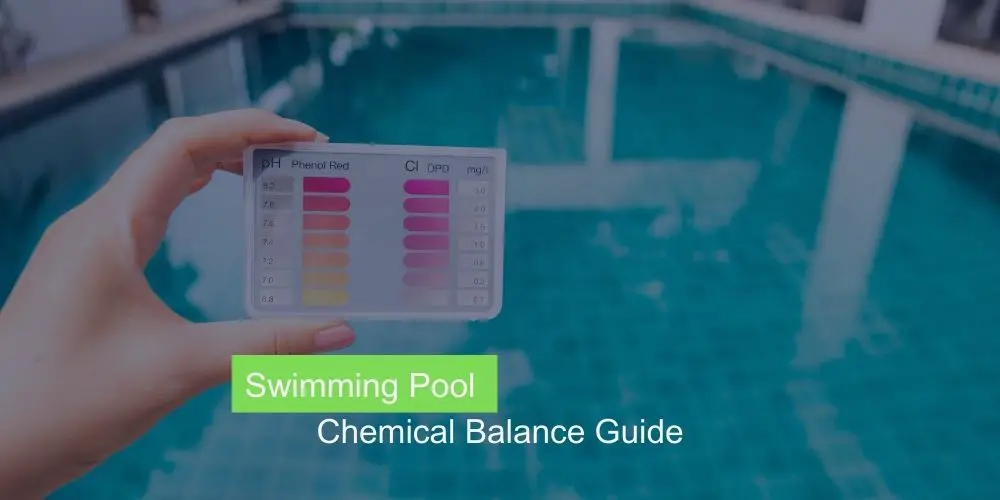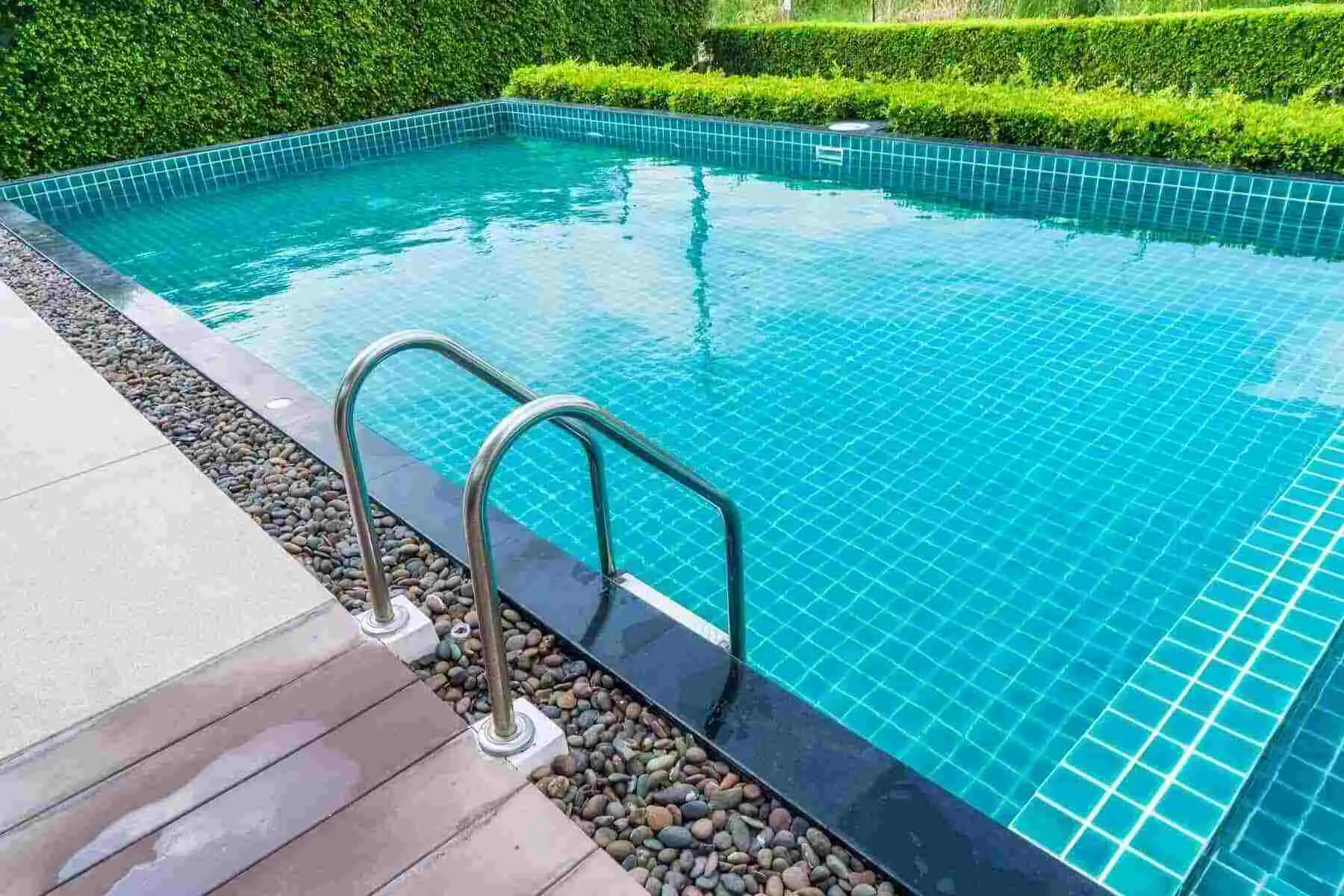
In the realm of swimming pools, achieving the perfect chemical balance is no less than striking gold.
Why so? Because maintaining proper chemical balance not only ensures a safe, crystal clear, and healthy pool but also prolongs the lifespan of your pool components.
But what could go wrong with an imbalanced pool? Well, the implications range from causing irritation to your skin and eyes to damaging your pool equipment.
4 Essential Parameters for a Balanced Pool

To ensure the safety and clarity of your swimming pool, you must balance several key parameters. These components determine the overall health of your pool and affect both the comfort of swimmers and the longevity of your pool materials.
1. pH Levels
The pH level of your pool measures how acidic or basic the water is on a scale from 0 to 14, with 7 being neutral. The ideal pH for a swimming pool is slightly basic, sitting around 7.4 to 7.6. A correct pH level guarantees the effectiveness of your chlorine and provides an environment that inhibits algae and bacterial growth. Too high or too low pH levels can lead to skin and eye irritations and even damage your pool equipment.
2. Alkalinity
Also known as ‘buffer,’ alkalinity plays an essential role in maintaining your pool’s pH level. It resists sudden pH changes, providing stability to your pool water. Keeping alkalinity levels between 80-120 parts per million (ppm) is crucial. Too high alkalinity can cloud your pool and cause scaling, while too low alkalinity makes your pool susceptible to dramatic pH swings.
3. Calcium Hardness
Calcium hardness tells us how hard or soft your water is. The concentration of calcium in your pool should be sufficient to avoid corrosive water conditions. Keeping the calcium hardness between 200-275 ppm for concrete pools is advised. For vinyl pools, a range of 175-225 ppm is ideal. Too low calcium hardness can corrode your pool equipment and etch your pool surface, while too high levels can lead to scaling and cloudiness.
4. Total Dissolved Solids (TDS)
TDS is a measure of all the combined organic and inorganic substances in your pool water. This includes minerals, salts, metals, cations, or anions dissolved in water. High TDS levels can reduce the effectiveness of your pool chemicals and cause cloudy water. It’s crucial to aim for a TDS level below 1500 ppm.
How to Balance Your Pool Chemicals in 3 Steps
Maintaining a chemically balanced swimming pool doesn’t need to be a daunting task. With some basic knowledge and the right tools, you can easily keep your pool water safe, clear, and comfortable for all to enjoy. Here’s a step-by-step guide:
1. Test the Pool Water
The first step in balancing your pool’s chemistry is testing the water. There are various methods for this, but the most convenient ones are test strips and digital test kits. Simply dip a test strip into your pool, wait for the strip to change color, and compare it to the color chart provided with the test kit.
Digital testers, while a bit more expensive, offer a more accurate reading. Alternatively, you can take a water sample to a local pool store for a professional testing service. This should give you accurate pH, alkalinity, calcium hardness, and total dissolved solids (TDS) readings.
2. Adjust pH and Alkalinity
Once you have your test results, it’s time to start adjusting your pool’s chemistry. If your pH is too high (above 7.6), you’ll need to add a pH reducer, often sold as “pH Minus” or “pH Down”. If the pH is too low (below 7.4), you’ll need a pH increaser, like “pH Plus” or “pH Up”.
For alkalinity, if the reading is too low (below 80 ppm), use a product called “Alkalinity Up” or “Alkalinity Increaser”. You can lower it by adding a pH reducer if it’s too high (above 120 ppm). It’s important to note that changing alkalinity can also affect pH, so you may need to adjust it again after it is balanced.
3. Adjust Calcium Hardness and TDS
To increase calcium hardness, use a product called “Calcium Hardness Increaser”. If the calcium hardness is too high, the best action is to drain and refill your pool with fresh water partially.
If TDS levels are above the recommended 1500 ppm, the most effective solution is typically to drain a portion of your pool water and refill it with fresh water.
After making any adjustments, wait at least a few hours (or ideally 24 hours) before testing the water again. This will give the chemicals time to circulate and do their job.
FAQs: Swimming Pool Chemical Balance Guide
1. How often should I test my pool water?
pH and Chlorine levels should be tested daily, Alkalinity weekly, and Calcium hardness and TDS monthly.
2. Can I swim right after adding chemicals to my pool?
It’s recommended to wait at least a few hours to allow the chemicals to distribute evenly throughout the pool.
3. Should I adjust alkalinity or chlorine first?
Between alkalinity and chlorine, you should typically adjust the alkalinity first. This is because the total alkalinity acts as a buffer for the pH level in your pool. Alkalinity can help to stabilize the pH level, which in turn, has a direct effect on the effectiveness of the chlorine.
4. Does high chlorine increase alkalinity?
Chlorine doesn’t directly increase alkalinity. However, depending on the type of chlorine you’re using, it can indirectly influence the pH and, consequently, the total alkalinity of your pool.
5. What causes pool alkalinity to rise?
The primary cause for rising pool alkalinity is the overuse of chemicals that raise pH, such as sodium carbonate or sodium bicarbonate, as these chemicals also increase alkalinity. Additionally, high alkalinity can occur due to high levels of dissolved minerals in the pool water, often resulting from using hard water (high in calcium and magnesium) to fill the pool.
Final Words
Achieving and maintaining the perfect chemical balance in your swimming pool is a critical aspect of pool ownership. While it may seem like a daunting task initially, with regular checks, a little understanding, and correct adjustments, it can be as straightforward as swimming on a warm summer day.
A well-balanced pool ensures a safe, clean, and enjoyable swimming experience while also prolonging the lifespan of your pool equipment. Dive into this guide whenever you need it, and make your pool the heart of countless joyful moments.

Hi, This is Josh. I am a former competitive swimmer and current fitness enthusiast.
I created this site to share my love of swimming with the world!

